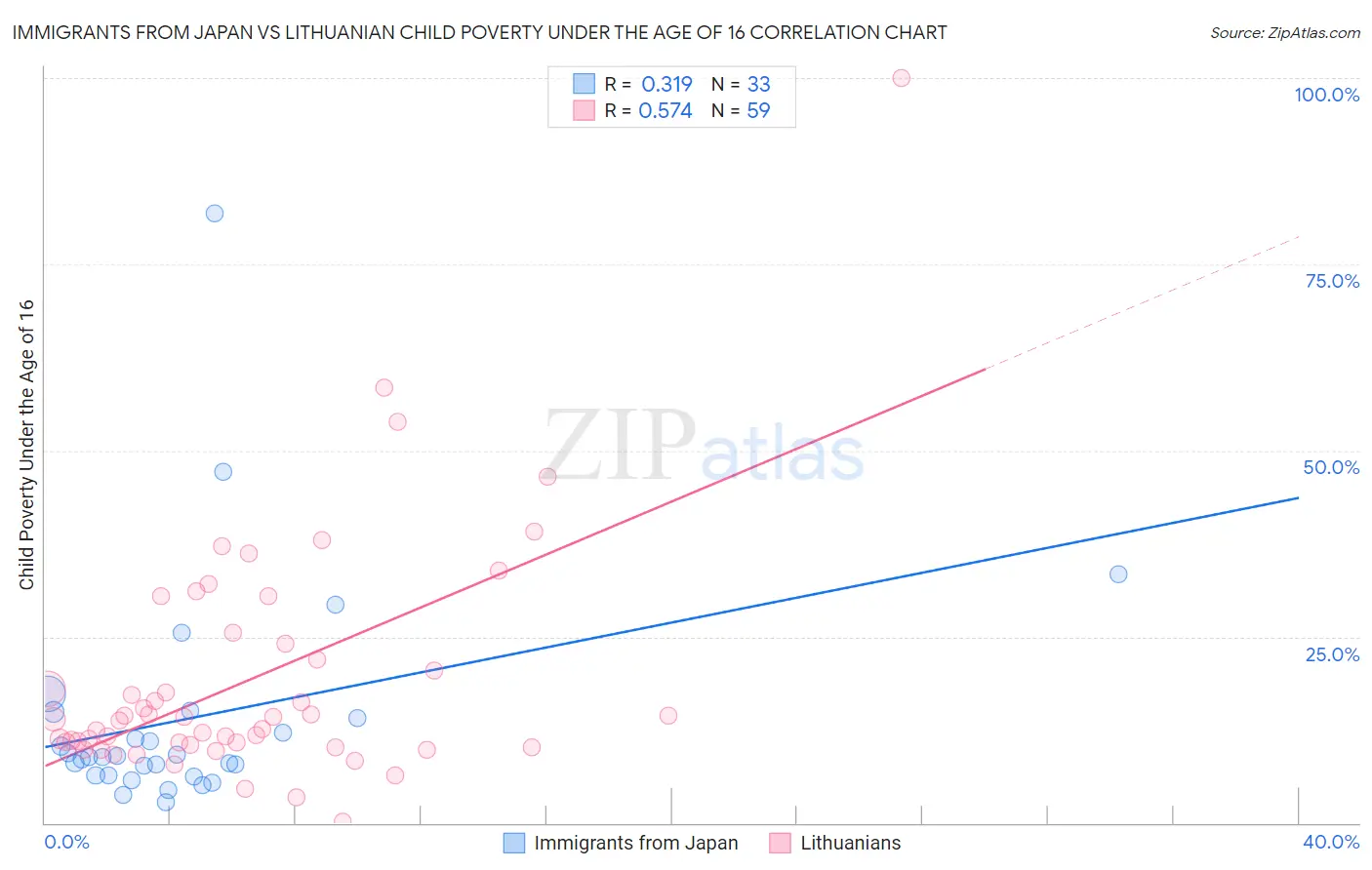Immigrants from Japan vs Lithuanian Child Poverty Under the Age of 16
COMPARE
Immigrants from Japan
Lithuanian
Child Poverty Under the Age of 16
Child Poverty Under the Age of 16 Comparison
Immigrants from Japan
Lithuanians
13.0%
CHILD POVERTY UNDER THE AGE OF 16
99.8/ 100
METRIC RATING
19th/ 347
METRIC RANK
13.5%
CHILD POVERTY UNDER THE AGE OF 16
99.6/ 100
METRIC RATING
35th/ 347
METRIC RANK
Immigrants from Japan vs Lithuanian Child Poverty Under the Age of 16 Correlation Chart
The statistical analysis conducted on geographies consisting of 337,592,497 people shows a mild positive correlation between the proportion of Immigrants from Japan and poverty level among children under the age of 16 in the United States with a correlation coefficient (R) of 0.319 and weighted average of 13.0%. Similarly, the statistical analysis conducted on geographies consisting of 415,877,620 people shows a substantial positive correlation between the proportion of Lithuanians and poverty level among children under the age of 16 in the United States with a correlation coefficient (R) of 0.574 and weighted average of 13.5%, a difference of 3.7%.

Child Poverty Under the Age of 16 Correlation Summary
| Measurement | Immigrants from Japan | Lithuanian |
| Minimum | 2.9% | 0.17% |
| Maximum | 81.8% | 100.0% |
| Range | 79.0% | 99.8% |
| Mean | 14.0% | 19.4% |
| Median | 8.9% | 13.9% |
| Interquartile 25% (IQ1) | 6.4% | 10.5% |
| Interquartile 75% (IQ3) | 14.5% | 24.0% |
| Interquartile Range (IQR) | 8.1% | 13.4% |
| Standard Deviation (Sample) | 15.4% | 16.2% |
| Standard Deviation (Population) | 15.1% | 16.1% |
Demographics Similar to Immigrants from Japan and Lithuanians by Child Poverty Under the Age of 16
In terms of child poverty under the age of 16, the demographic groups most similar to Immigrants from Japan are Cypriot (13.0%, a difference of 0.030%), Bulgarian (13.0%, a difference of 0.45%), Okinawan (13.1%, a difference of 0.59%), Immigrants from Eastern Asia (13.1%, a difference of 0.62%), and Maltese (13.1%, a difference of 0.70%). Similarly, the demographic groups most similar to Lithuanians are Russian (13.5%, a difference of 0.20%), Immigrants from Northern Europe (13.6%, a difference of 0.24%), Immigrants from Bolivia (13.6%, a difference of 0.26%), Asian (13.5%, a difference of 0.48%), and Tongan (13.4%, a difference of 0.97%).
| Demographics | Rating | Rank | Child Poverty Under the Age of 16 |
| Bulgarians | 99.9 /100 | #17 | Exceptional 13.0% |
| Cypriots | 99.9 /100 | #18 | Exceptional 13.0% |
| Immigrants | Japan | 99.8 /100 | #19 | Exceptional 13.0% |
| Okinawans | 99.8 /100 | #20 | Exceptional 13.1% |
| Immigrants | Eastern Asia | 99.8 /100 | #21 | Exceptional 13.1% |
| Maltese | 99.8 /100 | #22 | Exceptional 13.1% |
| Indians (Asian) | 99.8 /100 | #23 | Exceptional 13.1% |
| Latvians | 99.8 /100 | #24 | Exceptional 13.2% |
| Eastern Europeans | 99.8 /100 | #25 | Exceptional 13.2% |
| Bolivians | 99.8 /100 | #26 | Exceptional 13.2% |
| Immigrants | China | 99.8 /100 | #27 | Exceptional 13.3% |
| Assyrians/Chaldeans/Syriacs | 99.7 /100 | #28 | Exceptional 13.3% |
| Swedes | 99.7 /100 | #29 | Exceptional 13.3% |
| Turks | 99.7 /100 | #30 | Exceptional 13.4% |
| Danes | 99.7 /100 | #31 | Exceptional 13.4% |
| Tongans | 99.7 /100 | #32 | Exceptional 13.4% |
| Asians | 99.6 /100 | #33 | Exceptional 13.5% |
| Russians | 99.6 /100 | #34 | Exceptional 13.5% |
| Lithuanians | 99.6 /100 | #35 | Exceptional 13.5% |
| Immigrants | Northern Europe | 99.6 /100 | #36 | Exceptional 13.6% |
| Immigrants | Bolivia | 99.6 /100 | #37 | Exceptional 13.6% |